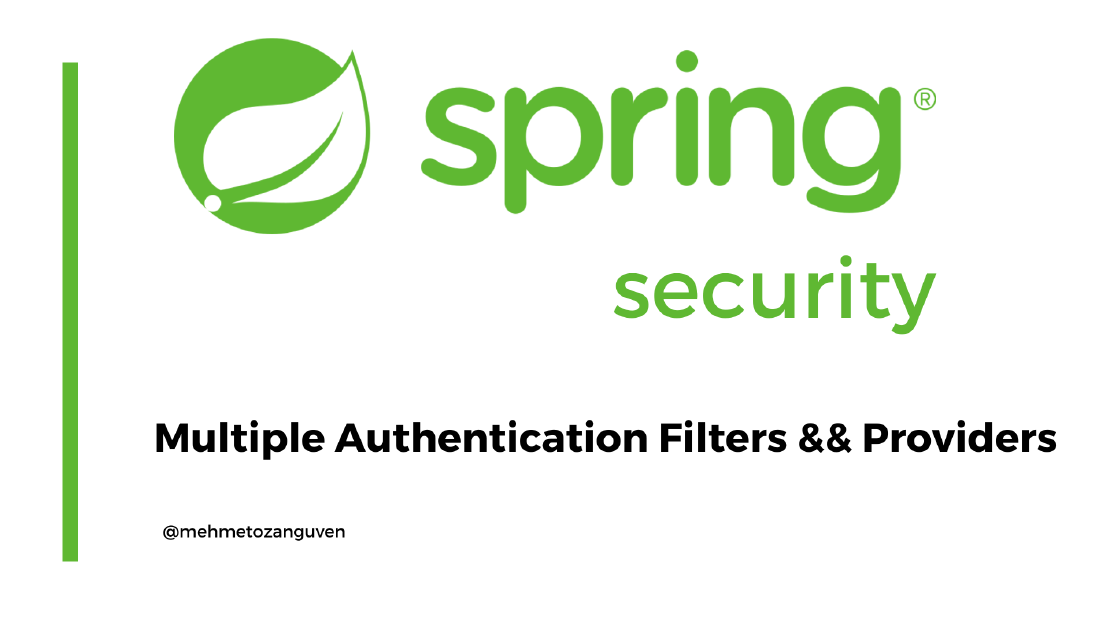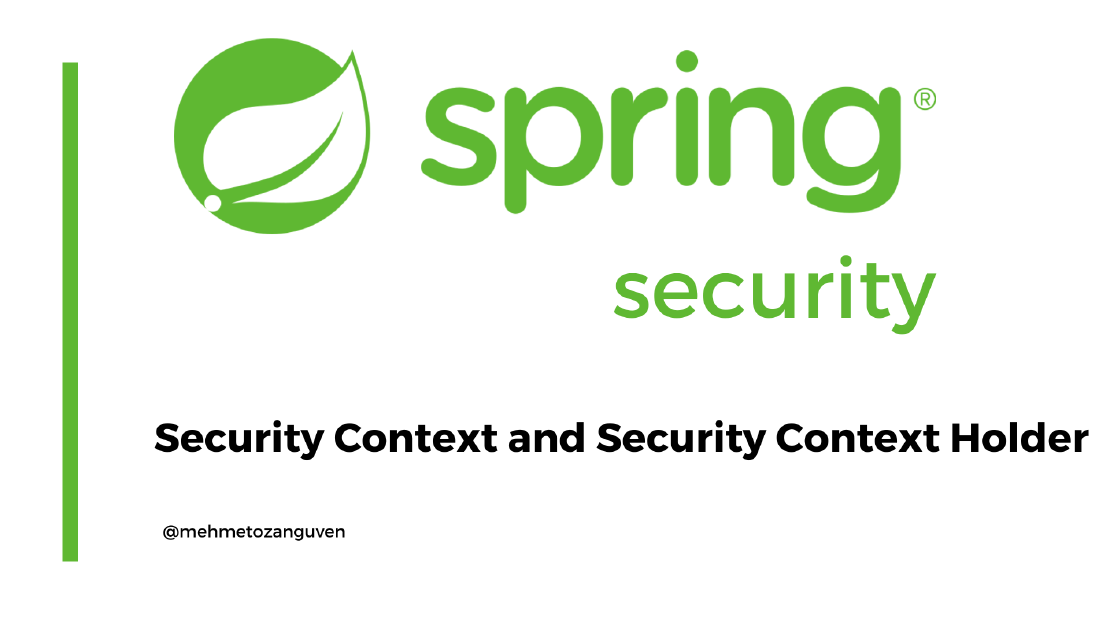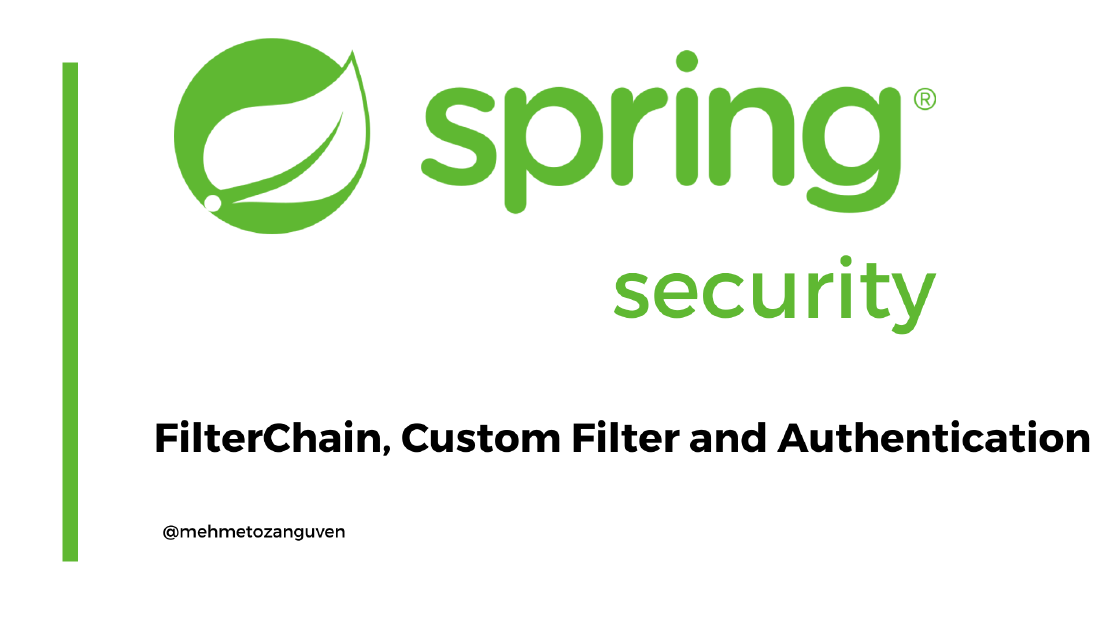
Spring Security -- 6) Multiple Authentication Filters && Providers
In this post, let’s implement two steps authentication mechanism. This will be similar to JWT authentication but instead of JWT I will use my …

In this post, let’s find out what the Security Context is
I am going to use the project that I have implemented in the previous post.
Here is the github link for previous project
If you only need to see the code, here is the github link
My OTP application can not be considered as secure. There are two main reasons:
- OTP codes does not have any expiration time
- Authorization header is stored in the hash map not in the database, could (most probably) lead to the memory leak
In the previous post, I have implemented OTP(one time password) with spring boot. Basically what I am doing:
Let’s try it: (I have already defined an user in the database –username: test_user, password: 1234 –)
curl -H "username:test_user" -H "password:1234x" -X GET http://localhost:8080/login
{
"timestamp": "2021-05-11T19:04:06.171+00:00",
"status": 500,
"error": "Internal Server Error",
"message": "",
"path": "/login"
}
curl -H "username:test_user" -H "password:1234" -X GET http://localhost:8080/login
testdatabase=# select * from otp;
id | username | otp
----+-----------+------------
1 | test_user | VxxLuQMzzG
-- assume that this otp will send to the user via mobile phone
curl -H "username:test_user" -H "otp:VxxLuQMzzG" -v -X GET http://localhost:8080/login
Note: Unnecessary use of -X or --request, GET is already inferred.
* Trying ::1:8080...
* Connected to localhost (::1) port 8080 (#0)
> GET /login HTTP/1.1
> Host: localhost:8080
> User-Agent: curl/7.69.1
> Accept: */*
> username:test_user
> otp:VxxLuQMzzG
>
* Mark bundle as not supporting multiuse
< HTTP/1.1 200
< Authorization: 9a98d974-6375-40cc-9086-6d93f955a1ee # HERE IS THE OUR TOKEN
< X-Content-Type-Options: nosniff
< X-XSS-Protection: 1; mode=block
< Cache-Control: no-cache, no-store, max-age=0, must-revalidate
< Pragma: no-cache
< Expires: 0
< X-Frame-Options: DENY
< Content-Length: 0
< Date: Tue, 11 May 2021 19:07:34 GMT
<
* Connection #0 to host localhost left intact
Now we can access to the restricted endpoints:
curl -H "Authorization:9a98d974-6375-40cc-9086-6d93f955a1ee" -X GET http://localhost:8080/hello
hello
In the previous project, we set the authenticated user in the filter, after getting the fully authenticated instance.
public class TokenAuthFilter extends OncePerRequestFilter {
// ...
@Override
protected void doFilterInternal(HttpServletRequest request, HttpServletResponse response, FilterChain filterChain) throws ServletException, IOException {
String authorization = request.getHeader("Authorization");
// create not-fully authenticated instance
TokenAuthentication tokenAuthentication = new TokenAuthentication(null, authorization);
// authenticationManager will find the correct provider
// and provider will return either fully authentication instance or
// throw an error
Authentication authResult = authenticationManager.authenticate(tokenAuthentication);
// Set the authentication in the SecurityContext
SecurityContextHolder.getContext().setAuthentication(authResult);
filterChain.doFilter(request, response);
}
}
If everything is okey, let’s discuss the SecurityContext
First, you can access SecurityContext in the anywhere in the application
In the endpoint level, easiest way to get authenticated user is to add Authentication parameter to the method.
If you look at the my previous post, when we are generating fully authenticated request via returning to the instance type of
Authentication
package com.mehmetozanguven.springsecuritymultipleproviders.controllers;
import org.springframework.security.core.Authentication;
import org.springframework.web.bind.annotation.GetMapping;
import org.springframework.web.bind.annotation.RestController;
@RestController
public class HelloController {
@GetMapping("/hello")
public String hello(Authentication authentication){
return "hello: " + authentication.getName();
}
}
curl -H "Authorization:74bc9635-8b9c-49f6-83d2-671f0ff7c20f" -X GET http://localhost:8080/hello
hello: 74bc9635-8b9c-49f6-83d2-671f0ff7c20f
authentication.getName() returns the token because in the TokenAuthProvider we set the principle as authorization token:
@Component
public class TokenAuthProvider implements AuthenticationProvider {
// ...
@Override
public Authentication authenticate(Authentication authentication) throws AuthenticationException {
// ...
if (isCorrectToken){
return new TokenAuthentication(authorizationToken, authorizationToken, List.of(() -> "read"));
} else {
throw new BadCredentialsException("Authorization value is not correct");
}
}
// ...
}
We can use the SecurityContextHolder class:
@RestController
public class HelloController {
@GetMapping("/hello")
public String hello(){
Authentication authentication = SecurityContextHolder.getContext().getAuthentication();
return "hello: " + authentication.getName();
}
}
In traditional way, when we do a request, application generates one thread. And this thread can handle the entire request. Problem arises when we have separate thread, how can we access the authenticated object in another thread ?
Just update the controller with @Async. This will generate another thread. (Also enable the async in the configuration)
@Configuration
@EnableAsync
public class ProjectBeanConfiguration extends WebSecurityConfigurerAdapter {
//...
}
@RestController
public class HelloController {
@GetMapping("/hello")
@Async
public String hello(){
Authentication authentication = SecurityContextHolder.getContext().getAuthentication();
return "hello: " + authentication.getName();
}
}
Run the application, and send request to the endpoint
curl -H "Authorization:f95742dd-9733-43aa-9776-8eaa95fb3130" -X GET http://localhost:8080/hello
Even if you get the 200 OK, look at the console, you will see the NullPointerException , because Authentication is null.
java.lang.NullPointerException: null
at com.mehmetozanguven.springsecuritymultipleproviders.controllers.HelloController.hello(HelloController.java:16) ~[classes/:na]
at com.mehmetozanguven.springsecuritymultipleproviders.controllers.HelloController$$FastClassBySpringCGLIB$$c071c780.invoke(<generated>) ~[classes/:na]
This happens because default thread (per request thread) will return 200 and actually this thread contains the authenticated user inside SecurityContextHolder.getContext().getAuthentication() . However, using @Async annotation, Spring will run the method in the different thread, and that thread don’t know the value of the SecurityContextHolder.getContext().getAuthentication() and it simply returns null.
Reason is that default strategy for the SecurityContextHolder is the MODE_THREADLOCAL
SecurityContextSecurityContextHolder implements strategies to manage SecurityContext
We can change the strategy when spring initializing the beans in the configuration file:
@Configuration
@EnableAsync
public class ProjectBeanConfiguration extends WebSecurityConfigurerAdapter {
// ...
@Bean
public InitializingBean initializingBean() {
return () -> {
SecurityContextHolder.setStrategyName(SecurityContextHolder.MODE_INHERITABLETHREADLOCAL);
};
}
}
Run the application after setting the strategy to:
@Configuration
@EnableAsync
public class ProjectBeanConfiguration extends WebSecurityConfigurerAdapter {
// ...
@Bean
public InitializingBean initializingBean() {
return () -> {
SecurityContextHolder.setStrategyName(SecurityContextHolder.MODE_INHERITABLETHREADLOCAL);
};
}
}
Now, when you hit the /hello request, you will not get the exception. (Everything works fine)
curl -H "Authorization:8a16be9e-573f-45bf-a8f1-6059518b60c8" -X GET http://localhost:8080/hello
Sometimes you may need to access the security context without changing the strategy, in that case you can wrap your runnable with DelegatingSecurityContextRunnable .
You can also wrap your
callable, executorServicewithDelegatingSecurityContextCallable, DelegatingSecurityContextExecutorService
Now undo the @Async operations (remove @EnableAsync and @Asycn) also remove the initializingBean() in the configuration and update the hello method:
@RestController
public class HelloController {
@GetMapping("/hello")
public String hello(){
Runnable runnable = () -> {
Authentication authentication = SecurityContextHolder.getContext().getAuthentication();
System.out.println(authentication.getName());
};
DelegatingSecurityContextRunnable ds = new DelegatingSecurityContextRunnable(runnable);
Thread thread = new Thread(ds);
thread.start();
return "hello";
}
}
And send the request:
curl -H "Authorization:b6347da7-9a69-4f25-b672-3d44fe0b28be" -X GET http://localhost:8080/hello
hello
I will continue with the next one …

In this post, let’s implement two steps authentication mechanism. This will be similar to JWT authentication but instead of JWT I will use my …

Let’s look at the Filter Chain, more specifically AuthenticationFilter in the Spring Security. And also I am going to implement custom filter. …